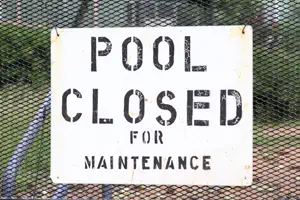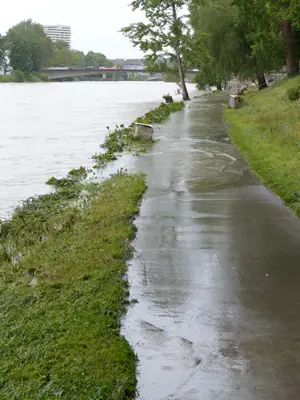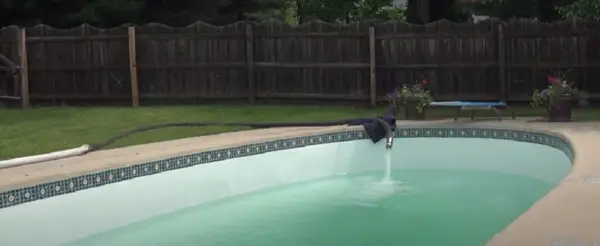If you know how to drain an inground pool, it could save you a lot of money and marital strife. Imagine having to tell your spouse that your pool popped out of the ground and the cost of repairs will be more than a new pool.
Table of Contents
Inground Pools Must Eventually Be Drained
There are a number of typical scenarios when draining a pool becomes necessary:
- If the pool needs to be painted
- When certain pool parts require repairs
- If the pool water has to be replaced
- If the pool’s finish has to be cleaned
The truth is that there will be a time when you will have to drain your pool if you’ve had it for long enough. It’s a good thing that this does not happen monthly, or even yearly.

However, you need to understand that you’ll likely have to drain your pool once every five or six years.
When it’s that time, it’s critical that the job gets done properly. Your inground pool could get seriously damaged if you drain it without using the correct process.
Read on if you want to know when you should drain your inground pool, how to safely drain it, and how to refill it afterward.
Why Drain Your Swimming Pool?
There are not many scenarios that will necessitate you to drain your pool completely and this is why you should only have to do it once every number of years. There shouldn’t be any reason why you should need to drain your pool if the reason isn’t described below.
Reset The Water’s Chemical Balance
Over time, the chemical balance of pool water can gradually get so out of hand that the best solution is to simply start anew. This is logical and eventually happens to all pools.
The water has likely been in the pool for many years and to keep it clean and hygienic, we constantly add various chemicals like chlorine and other sanitizers.
However, there is one factor that needs to be evaluated in this scenario. That is what becomes of the remnants of those chemicals, together with other contaminants such as dirt and debris.
These will build up over a long period and are referred to as the total dissolved solids (TDS) in the pool water. The TDS can have serious negative consequences for the chemistry of the water.
A pool water’s TDS can be measured with a digital meter or test strips. When it exceeds about 1,500 parts per million (ppm), it is time to drain the pool and start afresh.
Shown below is a Pool and Hot Tub Test Set. Get oit to know when to drain the pool in order to reset the pool chemical balance.
- SPECIAL EDITION: Our water tester comes in a modern and improved edition to give you accurate results. The PoolWaterLAB Photometer 15 in 1 gives you a modern solution for professional water analysis in whirlpools and pools. It has 6 quick access buttons for personal measuring methods.
- MULTI-FUNCTIONAL: With our 15 in 1 water tester, you can test up to 15 water parameters such as pH value Chlorine(free/combined/total), Alkalinity (Acid Capacity), Cyanuric Acid (Stabilizer), Active Oxygen (MPS), Bromine, Chlorine Dioxide, Ozone, Hydrogen Peroxide LR, Hydrogen Peroxide HR, Total Hardness, Calcium Hardness, Urea. You only need our water tester to test the 15 water parameters.
- FREE SOFTWARE: Our electronic water tester comes with free software that you can use in your PC and MAC. You can also use the free app for iOS and Android. You also get a free cloud service to help you synchronize data between your smartphone and computer. The cloud service also helps you store the data and make it easily accessible when you need it.
- POWER EFFICIENT: The electronic photometer doesn’t need a lot of battery power to work. It comes with 3 x AAA batteries that can run the water tester for a long time before replacing them. Our water tester is just what you need in your home or even in your pool business.
- EASY TO USE: You don’t need to hire a professional to help you use our water tester. Our water tester comes with a user manual that is easy to read and understand. The user guide is written in five languages English, German, French, Spanish, and Italian. It will take you through step by step on how to use the electronic water tester.
Pool Maintenance
Routine maintenance that has to be performed on a pool can most often be done without the water having to be drained. An automatic pool cleaner will for example be able to withstand being immersed in water.
If the pool however freezes during winter, some of the water should be removed from the pool in advance.
Also, there are scenarios where maintenance can only be performed when the pool is empty. These would include cleaning extreme metal stains and calcium deposits, repairing a cracked pool floor, and repainting the bottom of a pool.
When Your Pool Should Be Drained: 5-Step Checklist
A major rule of draining a pool is that it needs to be done as fast as possible to prevent pool popping or other damage. It is generally recommended that a pool should not be empty for over a week.
The checklist below will help ensure that your pool stays empty for the shortest possible time.
These Steps Will Help You Drain Your Inground Pool Safely
Step 1: It Should Be Sunny, But Not Too Hot!
Although it’s not a good idea to drain your pool in the pouring rain, you can also not do it on a day that’s too hot, as this may cause your pool to be damaged.
If it is drained during a heat wave, it is likely that there will be damage to the pool liner, and even pool walls and floors may crack.
An empty pool should not be exposed to temperatures exceeding around 85°F (29°C).
Step 2: When Your Budget Allows For It
It costs a fair amount to empty and refill the pool as you will have to drain and replace up to 20,000 gallons of water. It would be a good idea to make sure your budget can handle that month’s water bill.

Step 3: When You Have The Time Required
As mentioned before, you should plan that your pool doesn’t sit empty for more than a week. It’s never a good idea to pump thousands of gallons of water unattended, and you will need time to manage the process while it’s draining.
It normally takes at least 8 hours to drain the pool completely, and in extreme cases, it can take as long as 16 hours. Filling the pool will take about the same time.
Step 4: The Pool’s Chemical Levels Should Be As Low As Possible
It will likely be a local water authority requirement that pool water that is drained doesn’t contain high concentrations of pool chemicals. Contact your local water authority for their exact requirements.
Far before starting to drain the pool, stop treating the water. Use test strips to check that the water doesn’t contain high levels of chemicals, is chlorine neutral, and has a neutral ph.
Step 5: Prepare the Circulation System
The power to all pool systems should be switched off before the pool is drained.
If you leave the automatic timer on, the pump can come on while the pool is partly or fully empty. This will lead to air being pulled instead of water and will result in the pump overheating. The pump may even melt in extreme cases.
If a pool light comes on while it’s not covered in water, it will heat up and shatter as it is normally kept cool by the pool water.
Prevent Your Inground Pool Popping By Waiting Until After Spring Rains!
Although you may be tempted to skip this part about how to drain an inground pool safely, these precautions should be adhered to as there is a lot that may go wrong.
The biggest risk is what is known as the pool popping. In this scenario, the pool will act like a boat and it will be pushed upwards out of the ground when the groundwater level rises. The pool’s bottom is normally pushed out of place and this will crack the plastic pipes underneath it. The pool shell itself may also crack.

This will result in the pool’s top edge coming loose or cracking, leading to the concrete decks surrounding the pool being damaged.
In addition, the electric wiring of the pool light will be damaged, which adds the risk of electrocution.
Homeowners’ insurance will most often not cover that type of damage. The safest way to prevent a pool popping when it is emptied is to hire a professional company to do the job. The contractor’s insurance will then pay for damages if something goes wrong.
This is particularly true if there is a high risk of it happening, i.e. if your area has a high water table, or if it has recently rained.
High water tables are created when water saturates the ground. This can occur anywhere, especially after heavy rain.
The rainwater soaks into the earth and combines with water sources that already exist, like underground streams, springs, or lakes. When those natural water sources can’t hold more water, the below ground water will rise towards the surface.
The steps explained below will help you in avoiding this specific problem.
Plan Where You Will Pump the Water
Before you start draining your pool you should have a plan in place where you’ll be moving thousands of gallons of water to. Here are the guidelines for Mesa, AZ
Simply pumping the water into the yard is not an option. That water will turn into a lake under your pool and try to push the inground pool up out of the ground. You’re sure to regret it if you pump the water into the ground close to the pool.
You also don’t want that water full of chemicals going into your garden as it may kill off your plants and grass.
Contact the local water authority to determine where you are allowed to pump the water. It is normal to pump the water into a household sewer drain, but that means the sewer plant will have to treat the extra water.
This is often preferable to pumping the water into the street storm water drain as that may cause harm to the water quality of local rivers and streams.
Most counties and cities have restrictions regarding where a pool may be drained. Check your local government’s website to familiarize yourself with the regulations that apply to you.
Make sure the drainage hose will get to the point where the local authority will permit you to drain the water to prevent your pool from popping up.
Also, ensure the hose outlet is positioned downhill from the pool in case other drainage problems occur.
If you pump thousands of gallons of water into the sewer pipe, you may find out that it is partially clogged. Although many household drain pipes are partly plugged with grease and fats, this will normally still allow normal amounts of water to pass through. However, with big volumes of water, that partial clog will act like a dam and all the water will push back into the yard or house.
If something goes wrong and the water moves back toward you, you want to make sure it’s not close to your pool.
Your Pool Should Not be Drained Shortly after a Rainstorm
It’s never good to drain a pool during stormy weather. If rainwater has sunk into your yard recently, there will be more water pressure under and around the pool. Which increases the risk of your pool popping out of the ground as the water is pumped out.
Ideally, the ground should be allowed to dry out for a few weeks before you start to drain the pool. Although the ground surface may seem to be dry, this doesn’t mean the earth lower down is also dry. You don’t want to find this out by having your pool pop up.

Check The Pool’s Hydrostatic Relief Valves
A pool’s hydrostatic pressure relief valves are safety features that have specifically been designed to prevent a pool popping up. You may not even be aware that these exist if you’ve never drained a pool.
If you look at the bottom of a pool, you’ll see white rings that are cemented into the floor. Those are attached to a pipe underneath the pool that leads to a gravel pit under the pool.
These valves will permit underground water to push up into a pool when its water is drained. Without these valves, the underground water could create sufficient pressure to result in your pool popping.
These rings should be removed to relieve the pressure when the pool is close to being completely drained. Make sure you have a few spares available in case they are damaged while removing them.
The Draining Process in 5 Easy Steps
Now that you know how to drain an inground pool, you can start the actual process.
1. Drain Your Pool With a Submersible Pump
A regular pool pump was designed to suck in water so you can’t use it to drain your pool as it will suck in air as the pool starts draining. This may result in it being permanently damaged.
You should rent or buy a submersible pump to empty your pool. This is not that expensive.
Check that the submersible pump’s power cord will be able to reach from the middle of the deep end of the pool floor to the outlet. Don’t use an extension cord if possible as it’s safer not to.
Connect a hose to the submersible pump and place the other end wherever the water should be pumped to.
- 1/2 HP Utility pump moves up to 3,300 gallons per hour; pump will lift water up to 25′ of vertical height
- Tough thermoplastic construction; 10′ cord length
- 1-1/2 inch NPT discharge for high capacity pumping; includes 3/4 inch garden hose adapter; Amps:4.9
- Removable suction screen and handles up to 3/8 inch solids
- Superior Pumps are Built to Last, engineered with quality components and are 100% factory tested
2. Start the Draining Process
Turn the submersible pump on to start draining. This normally means placing the pump in the water and plugging it into an electrical outlet. To prevent both you and the pump from being fried, use a GFCI-protected electrical outlet.
You’ll need to monitor this, irrespective of how long it takes. Regularly check the cord and hose to ensure that all keeps running smoothly and accidents don’t happen.
You may want to consider converting your pool to saltwater when you drain it. This will help the chlorine to work at the lowest, safest, and most consistent levels possible.
3. Remove the Pump
The water will be pumped out to a level where it becomes too low for the submersible pump to pump any more out of the pool. This is normal and every inch of water can’t be drained.
You may consider switching to a pool cover pump which can normally pump water down to a lower level (about 1 inch). Pool cover pumps however have lower flow rates and it will take longer to drain your pool.
The leftover water won’t affect the chemical balance of the pool when you refill it. Switch off and remove the pump.
4. Open the Pressure Relief Valves
Ease the pressure of the underground water by opening the hydrostatic pressure relief valves as this will prevent pool popping.
5. Perform the Work That Led You to Drain the Pool
If the goal of draining the pool was to fix the chemical balance, you can start refilling it immediately by using the steps described below.
If there is other work to be done, such as repairing or painting the pool, this can be done now.
If the work requires that the floor be totally dry, you can use a heavy-duty, durable cover pump like the Sunnora 1500 GPH Pool Cover Pump.
Take the steps described below to refill your pool as soon as possible. Remember, your pool should not be left empty for longer than a week.

Refilling an Inground Pool in 3 Easy Steps
Knowing how to drain an inground pool and doing it correctly is crucial. Happily, refilling a pool is much easier than draining it, although you will have to rebalance the water and it will take some time.
1. Replacing the Pressure Relief Valves
The pressure relief valves should not be open while filling up the pool as this would cause the water to fill the gravel pit, creating huge pressure. Use Teflon tape on the threads of the plug and twist it into the valve tightly.
Shown below is the Hayward SP1056 Hydrostatic Relief Valve for pools. If you don’t have one, get one now.
- Brand Name: Hayward
- Comply with provisions of ASME/ANSI A112.19.8 2007
- Country of Origin: China
- Model Number: SP1056
2. Refilling the Pool and Switching on the Circulation Pump
Refill the pool using as many garden hoses as you have available.
If your water source contains iron, manganese, copper, or chromium metals it’s worthwhile to use hose filters to remove the metals. Failing to do this will result in you having to later fix ugly metal stains.
This may even lead to you having to drain the pool again and that’s definitely not something you want to do if you can help it.
3. Balancing the Water Chemistry
You will have to balance the water chemistry from scratch, and this could well be the trickiest part of the whole exercise. Get your pool chemicals here.

It’s Time to Enjoy Your Pool!
Well, maybe not quite yet. It may be a good idea to get a pool heater as all that fresh water will probably be slightly too cool for comfort. You are now ready to enjoy a summer full of relaxation and fun in the pool. Enjoy!
Related article:
How to Get Water Off Pool Cover Using Pool Cover Pumps

Author at Best Sump Pumps
The first time I helped to install a drain tile and basement sump pump system was 1978.
Since then I have worked for a city water utility where I worked with and maintained pumps.
My rental properties and personal homes all needed sump pumps.
As a modular home dealer/builder, those new homes needed sump pumps.
I put that experience to good use by providing reliable, useful, and practical advice on buying, using, and maintaining sump pumps.




